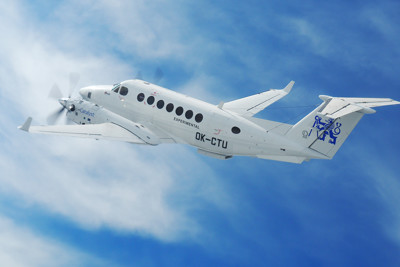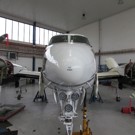LRI-AAST: L3 laboratory: Flying test bed
| Lab | Equipment | Application |
|---|---|---|
| L3 | Flying test bed | The flying test bed is an aeroplane (Beechcraft King Air 350) intended for flight research or testing the aircraft concepts or on-board equipment. |

 CTU Flying Test Bed has been designed to develop knowledge and skills by conducting research in the area of modern turboprop
aircraft engines, innovative materials and testing its research hypotheses, including flight testing, to validate technologies.
Focus is set on aircraft engine performance and operability validation vs. performance requirements and cycle deck validation.
CTU Flying Test Bed has been designed to develop knowledge and skills by conducting research in the area of modern turboprop
aircraft engines, innovative materials and testing its research hypotheses, including flight testing, to validate technologies.
Focus is set on aircraft engine performance and operability validation vs. performance requirements and cycle deck validation.
It is derived from FAR23, twin-engine Beechcraft King Air 350.
Such a proven aircraft platform satisfies the following characteristics or is capable of:
- Flight of up to 35,000 ft with a pressurized cabin in speed range of 100 to 260 KIAS
- Level flight with one engine inoperative at least at 20,000 feet pressure altitude on an ISA day
- Aircraft cabin configuration for 2 research engineers plus 2 flight test engineers with access to on board Data Acquisition System output via LAN connection
- Electrical system adapted for FADEC-type engine control
- Fuel management, allowing sensing of pressure, temperature and mass flow
- Bleed air distribution, allowing sensing of air pressure, temperature and mass flow
- Engine inlet and Oil cooler channels instrumentation to assess installation losses
- FADEC-type engine control with interface for FADEC test system
- Electrical system power management with power draw sensing of users on aircraft buses
- Electric power extraction capable of absorbing of up to 29HP equivalent
Test Propulsion System Details
Basic characteristics of test engine and propeller models can be accommodated as follows:
| Category | Sub-category | Unit | Reference value |
|---|---|---|---|
| Engine Weight | Dry | Lbm | 445 – 775 |
| Engine Weight | Wet | Lbm | 460 – 870 |
| Engine Diameter | inch | 15 – 23 | |
| Engine Length (without accessories) | inch | 50 – 71 | |
| Propeller flange distance from engine mount plane | inch | 33 – 46 | |
| Engine C.G. Locations - installed accessories, no propeller | forward from mount plane | inch | 2,56 – 3,61 |
| Engine Airflow | Lbm/sec | 8,1 – 11,5 | |
| Rated Horsepower | SHP | 900 – 1300 | |
| Engine Thrust (with propeller and exhaust) | lbf | 2250 – 7870 | |
| Max Torque | Lb.ft | 1480 – 4500 | |
| Fuel Consumption | Take Off | Lb/h | 500 – 800 |
| Number of Propeller blades | - | 3 – 5 | |
| Propeller Diameter | Inch | 95 – 105 | |
| Dry, rotating prop weight | Lbs | 145 – 235 |
Aircraft Data Acquisition System Description
Aircraft is equipped with Data Acquisition System interfacing with sensors installed within the nacelle, but not limited to, and capable of recording data from the following number of channels:
- Low Frequency inputs:
- 90 thermocouple inputs, with 24bit precision of the A/D converter, with a 100Hz sampling frequency
- 110 voltage inputs (pressure transducers and strain gages), with 24bit precision of the A/D converter, with a 20 kHz sampling frequency
- High Frequency inputs:
- 100 voltage inputs (accelerometers and strain gages), with 24bit precision of the A/D converter, with a 200 kHz sampling frequency
- 100 voltage inputs (ECS, flight deck, spares), with 24bit precision of the A/D converter, with a 200 kHz sampling frequency
- 2 camera inputs, with minimum of 25 frames per second, minimum SD quality
- Up to 3 interfaces for Scanivalve MPS 4264 Pressure Scanner
- The DAS records FADEC parameters communicated via ARINC 429 and RS-422 databuses
- The DAS allows for real-time acquisition and conversion, and display, of the data into engineering units.
- Data storage system consists of 4 removable SSD drives for easy data download

![[design/2014/cvut-logo-en-blue.png]](https://www.fs.cvut.cz/content/images/design/2014/cvut-logo-en-blue.png)
![[design/2014/cvut-logo-print.jpg]](https://www.fs.cvut.cz/content/images/design/2014/cvut-logo-print.jpg)



